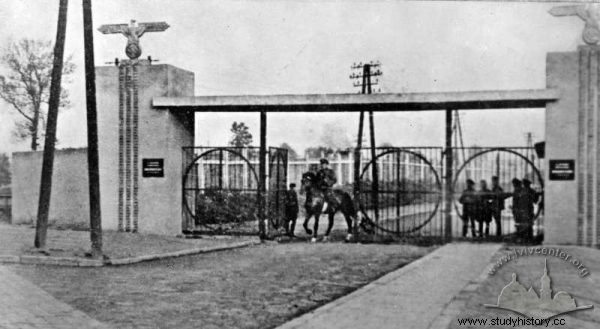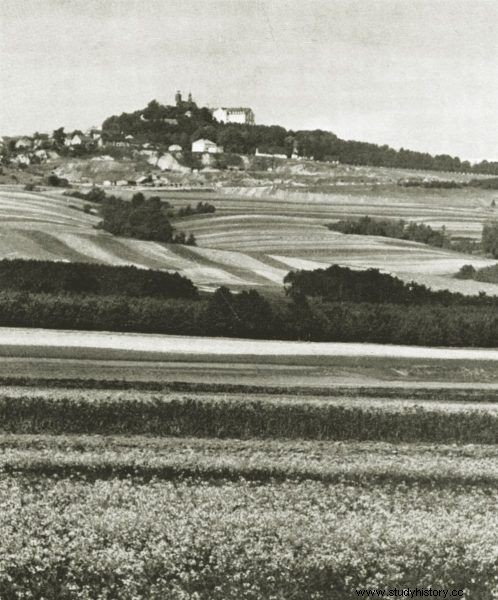We remember Auschwitz, Majdanek and Sobibór. But what about the hundreds of labor and death camps where the most horrible crimes were committed and which have completely disappeared from our consciousness? We remind you of four such places, located in the area of pre-war Poland.
A labor camp at the Lublin airport
People visiting Lublin to see the extermination site at Majdanek rarely realize that it was not the only German camp operating in the city. In 1940, the pre-war airport located near the center of Lublin was liquidated, and a forced labor camp (commonly known as the camp at the airport or the camp at Flugplatz) was established on its territory. There were numerous workshops where not only Jews from various countries were forced into slave labor, but also women of Polish nationality. The inmates were given the disgusting task of sorting their belongings taken from the victims murdered in the death camps.
The peculiar and disgusting aspect of the operation of the labor camp at the airport is mentioned by Martin Winstone in his work Places of the Holocaust in Europe. As he writes, in the camp, "there was a restaurant considered to be the best in Lublin; Himmler ate there three times. Ironically, the people who supervised the genocide of Polish Jews were served by young and beautiful Jewish women. ”
The Janów camp in Lviv
Already a few months after the invasion of the Soviet Union by the Third Reich, the extermination of the Jewish population in newly occupied Lviv began. The Deutsche Ausrüstungswerke company, controlled by the SS, took over the factory on Janowska Street, previously owned by a Jewish family. It became the heart of the newly created camp, to which initially men were sent to be caught in the streets of Lviv.
From the very first moment, the Germans made a ruthless selection of prisoners:those found incapable of work were immediately taken to a nearby ravine and murdered. The same fate awaited people who were incapable of slave labor beyond their strength. The guards of the Janów camp were not only characterized by exceptional cruelty, but also by repulsive tendencies to play with human life.

Central entrance to the Janów camp in Lviv, 1944
For example, they organized "death races" around the camp fence. The one who ran the slowest (or whoever they had their feet up) was taken to the ravine and killed. The commandant of the camp, Gustav Wilhaus, and his wife were also fond of similar "entertainment":for example, they would go out to the balcony of the commandant's office and shoot prisoners with it to make their nine-year-old daughter laugh.
In total, up to 200,000 people died in the camp. They were murdered, starved or died of untreated diseases.
Camp on Saint Anne's Mountain
The camp, set up on the slopes of one of the most famous hills in southern Poland, did not go down in history by itself. It was almost completely forgotten, although to this day there are fruits of the slave labor of the workers imprisoned there. They were building, working 24 hours a day in two shifts, seven days a week, the German RAB29 motorway, which was to connect Wrocław with Katowice. This route still exists in part as the Polish national road number 88.

This article was inspired by Maciej Siembieda's latest novel, "The Place and the Name" (Big Letter 2018).
According to the magazine "Virtual Shtetl" on the basis of the work Jews in Nazi camps in Opole Silesia :“The inhuman work system and the very poor living conditions in the camp caused the number of workers to decline rapidly. In addition, numerous selections were carried out which eliminated prisoners who were unable to work, but actually exacerbated the increasing shortages of manpower. "
However, much more cannot be said about the camp on St. Anne's Mountain. This is one of the particularly mysterious modes in the German death machine. As emphasized by Janusz Oszytko from the Opole branch of the Institute of National Remembrance, "the literature on this camp is extremely thin", the reports are sparse and contradictory. As a result, although people died here every day, it is impossible to estimate the number of victims.
There are no reports of work on the motorway, at least not from the victims of this particular camp. Also, little is known about what kind of work the imprisoned Jews were forced to do when the road works were completed. The mysterious history of the camp arouses the interest of researchers and writers who try to recall the suffering of German camp prisoners in the form of prose. The last one was Maciej Siembieda - the author of the novel "Place and Name", the key plot of which takes place in a camp near Opole.

Annaberg, today's St. Anne's Mountain, in the 1930s
The camp in Izbica
Izbica, located in the Lubelskie Province, was one of the numerous Polish cities that lost their privileges as part of the repressions after the January Uprising. Although it had over 6,000 inhabitants in the interwar period, it never regained its city rights. On the other hand, she was widely known for her mocking poem. The settlement was said to be "Izbica - the Jewish capital", which was justified by the population of the town. People of Jewish descent made up over 90% of Izbica's inhabitants.
In 1942, the entire town was transformed into a large ghetto for 26,000 Jews. The existing residents were quickly removed from it - in March of that year, 4,000 members of the local community were moved to Bełżec and murdered. Others were also killed in the Izbica cemetery and in Sobibór. Only thirteen Jews from Izbica survived the war, and only the buildings and the name of the old village remained.
Read also about the Schmelt Organization - a criminal German corporation that created and managed camps like the one on Mount St. Anne, disregarding human life.
- M.M. Borwicz, University of thugs. About the Janów Camp in Lviv 1941-1944 , High Castle 2014.
- R, Kuwałek, From Lublin to Bełżec:traces of the presence and extermination of Jews in the south-eastern Lublin region , Adrem 2006.
- Labor camp at the Flugplatz , "NN Theater".
- Labor camp - Zwangsarbeitslager Annaberg , "Virtual Shtetl".
- J. Oszytko, A forced labor camp for Jews on St. Anne's Mountain (1941-1945) [in:] Jews and Judaism in contemporary Polish research, ed. K. Pilarczyk, S. Gąsiorowski, Polish Academy of Learning 2000.
- K. Świerkosz, Jews in Nazi camps in Opole Silesia during World War II [in:] 45. anniversary of the Warsaw Ghetto Uprising (1943–1988) , materials from the popular science session, Opole 1988.
- M. Winstone, Holocaust Sites in Europe, Bellona 2017.
Buy the book at a discount on empik.com

